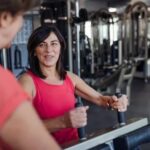Are you looking to achieve a fit body without spending hours at the gym? In this article, we will explore the concept of getting in shape without traditional exercise and discuss alternative methods for achieving your fitness goals. From understanding the role of diet and nutrition to incorporating physical activity into daily routines, we will uncover various ways to improve your physical health without relying solely on traditional workouts.
Many people may be surprised to learn that it is possible to attain a fit body without engaging in traditional exercise routines. By focusing on aspects such as diet, lifestyle changes, stress management, and quality sleep, individuals can make significant strides towards achieving their fitness goals. Additionally, alternative forms of movement such as yoga, dancing, and hiking offer diverse options for staying active and improving overall health.
Throughout this article, we will delve into various strategies for achieving a fit body without traditional exercise. From exploring the impact of nutrition on overall fitness to discussing the use of technology and online workout programs, we will offer actionable steps for readers to implement in their own lives. So if you’re interested in learning how to get fit without hitting the gym every day, read on for tips and insights on attaining a healthier lifestyle.
Understanding the Role of Diet in Achieving a Fit Body
Achieving a fit body without traditional exercise is definitely possible, and one of the key factors in this equation is nutrition. The role of diet in achieving a fit body cannot be overstated, as what we put into our bodies has a direct impact on our overall fitness. A balanced and nutritious diet can help individuals achieve their fitness goals without relying solely on physical activity.
Nutrition plays an important role in weight management, muscle building, and overall health. Consuming the right balance of macronutrients (carbohydrates, protein, and fats) and micronutrients (vitamins and minerals) is essential for supporting the body’s functions, energy levels, and metabolism. By focusing on nutrient-dense foods such as fruits, vegetables, lean proteins, whole grains, and healthy fats, individuals can fuel their bodies appropriately for physical activities while also promoting overall health.
In addition to the types of food consumed, portion control also plays a significant role in achieving a fit body without exercise. Overeating can lead to weight gain and other health issues, so being mindful of portion sizes is crucial. Understanding how food choices impact overall fitness can empower individuals to make healthier decisions when it comes to their diet.
| Nutrition | Impact |
|---|---|
| Macronutrients & micronutrients | Essential for body’s functions and metabolism |
| Nutrient-dense foods | Promote overall health and support physical activities |
| Portion control | Helps prevent weight gain and promotes better health outcomes |
Incorporating Physical Activity Into Daily Routines
Walking and Taking the Stairs
One simple way to incorporate physical activity into your daily routine is by walking whenever possible. Instead of driving short distances, consider walking to your destination. You can also take the stairs instead of the elevator whenever feasible. These small changes may seem insignificant, but they can add up over time and make a difference in your overall fitness.
Active Errands and Chores
Turning everyday errands and chores into opportunities for physical activity is another effective way to stay active without traditional exercise. For example, you can do some squats while doing laundry or incorporate lunges while vacuuming. Simple activities like gardening, cleaning, or even grocery shopping can be turned into mini workouts with a bit of creativity and intention.
Desk Exercises
For those who have desk jobs, incorporating exercises that can be done at your desk can help keep you active throughout the day. Simple exercises like leg lifts, chair squats, or stretching at regular intervals can help improve circulation, reduce stiffness, and contribute to overall fitness even while sitting for extended periods.
By making these small lifestyle changes and incorporating physical activity into your daily routines, you can achieve a fit body without relying solely on traditional exercise methods. These habits not only contribute to physical health but also improve mental well-being and overall quality of life.
Exploring Alternative Forms of Movement
For individuals looking to achieve a fit body without traditional exercise, incorporating alternative forms of movement can be a game-changer. Activities such as yoga, dancing, and hiking offer unique opportunities to engage in physical activity while still enjoying the experience. Yoga, for example, not only improves flexibility and strength but also promotes relaxation and stress reduction through its focus on breathing and mindfulness.
Dancing is another fantastic way to get moving and improve cardiovascular health. Whether it’s through structured dance classes or simply turning up the music and dancing around the house, this form of movement can elevate heart rate, burn calories, and contribute to overall physical fitness. Additionally, the social aspect of dance can provide psychological benefits such as improved mood and confidence.
Hiking is yet another alternative form of movement that offers both physical and mental health benefits. It provides a low-impact cardiovascular workout, as well as the opportunity to connect with nature and reduce stress levels. Research has shown that spending time outdoors can have a positive impact on mental well-being, making hiking an excellent option for those seeking a fit body without traditional exercise.
These activities not only add variety to one’s fitness routine but also offer holistic benefits for both physical and mental well-being. By incorporating these forms of movement into daily life, individuals can work towards achieving a fit body without exclusively relying on traditional exercise methods.
| Alternative Forms of Movement | Benefits |
|---|---|
| Yoga | Improves flexibility and strength; Promotes relaxation and stress reduction |
| Dancing | Improves cardiovascular health; Provides psychological benefits such as improved mood and confidence |
| Hiking | Provides low-impact cardiovascular workout; Reduces stress levels through nature connection |
Stress Management and Its Impact on Physical Health
Stress is a common factor in many people’s lives, and its impact on physical health should not be underestimated. When it comes to achieving a fit body without traditional exercise, managing stress plays a significant role. Cortisol, the primary stress hormone, can have a direct impact on body composition and overall fitness levels.
The Connection Between Stress and Cortisol Levels
When we experience stress, the body releases cortisol as part of the “fight or flight” response. While this hormone is necessary for survival in certain situations, chronically elevated cortisol levels can have detrimental effects on the body. High levels of cortisol have been linked to increased abdominal fat storage, reduced muscle mass, and even decreased bone density. This can ultimately hinder an individual’s efforts to achieve a fit body.
Strategies for Managing Stress
In order to minimize the negative impact of stress on physical health, it is important to develop effective stress management techniques. These may include practices such as meditation, deep breathing exercises, mindfulness techniques, or engaging in activities that bring joy and relaxation. Additionally, ensuring adequate rest and recuperation time is also essential for keeping cortisol levels in check.
By understanding the connection between stress, cortisol levels, and body composition, individuals seeking to achieve a fit body without traditional exercise can focus on implementing stress management strategies as part of their overall approach to wellness. Prioritizing mental well-being not only contributes to a healthy lifestyle but also supports physical health and fitness goals.
The Importance of Sleep
Adequate sleep is crucial for overall health and plays a significant role in achieving and maintaining a fit body. Here’s how quality and quantity of sleep impact your physical fitness:
1. Body composition: Lack of sleep can disrupt the balance of hormones that control appetite, leading to increased cravings for unhealthy foods. Poor dietary choices can hinder your progress towards a fit body without exercise.
2. Muscle recovery and growth: During deep sleep, the body repairs and rebuilds muscle tissues that are stressed during physical activity or daily movements. Without sufficient sleep, the ability to recover and grow strong muscles may be compromised.
3. Energy levels: Quality sleep ensures that you have adequate energy to engage in daily physical activities such as walking, taking the stairs, or incorporating movement into other aspects of your routine.
To maximize the benefits of sleep for achieving a fit body without traditional exercise, consider implementing the following tips:
By prioritizing quality and quantity of sleep, you can support your overall health and wellness goals even without engaging in structured exercise routines. Achieving a fit body is not just about physical activity but also about giving your body the rest it needs to function optimally.
Utilizing Technology for Fitness
In today’s digital age, technology has become an integral part of our lives, and it can also be a valuable tool for achieving a fit body without traditional exercise. With the rise of fitness apps, online workout programs, and other technological tools, individuals now have more options than ever to stay active and healthy without hitting the gym.
These resources can provide guidance, motivation, and support for those looking to improve their physical fitness without engaging in traditional exercise routines.
One of the main advantages of utilizing technology for fitness is the convenience it offers. With fitness apps and online workout programs, individuals can access a wide range of exercises and training plans from the comfort of their own homes.
Whether it’s a quick HIIT (high-intensity interval training) session during a lunch break or a yoga class before bed, these tools make it easier than ever to incorporate physical activity into daily routines without having to dedicate large chunks of time to traditional exercise.
Another benefit of using technology for fitness is the ability to track progress and set goals. Many fitness apps offer features such as workout tracking, progress reports, and goal setting that can help individuals stay motivated and accountable in their fitness journey.
By monitoring their activity levels and setting achievable targets, people can gradually improve their physical health over time without engaging in traditional exercise routines. Additionally, some apps also provide nutritional guidance and meal planning tools to support overall wellness and body composition improvement.
Moreover, these technological tools also offer a sense of community and support. Many fitness apps and online workout programs include social features that allow users to connect with like-minded individuals, share achievements, and participate in challenges or group workouts. This sense of community can provide additional motivation and encouragement for those looking to achieve a fit body without traditional exercise while also fostering a supportive environment for maintaining healthy habits in the long run.
Conclusion
In conclusion, achieving a fit body without traditional exercise is possible through a combination of mindful nutrition, incorporating physical activity into daily routines, exploring alternative forms of movement, managing stress levels, prioritizing quality sleep, and utilizing technology for fitness. By understanding the impact of diet on overall fitness and making small lifestyle changes to incorporate physical activity into everyday life, individuals can make significant progress towards their fitness goals without traditional gym workouts.
It’s important to recognize the impact of stress on physical health and body composition, as high levels of cortisol can hinder progress towards a fit body. Managing stress through relaxation techniques, mindfulness practices, and regular self-care can contribute to overall health and well-being. Additionally, prioritizing quality sleep and ensuring adequate rest can support the body’s natural healing and recovery processes, ultimately impacting fitness levels.
Furthermore, modern technology offers a variety of resources for achieving a fit body without traditional exercise. Fitness apps, online workout programs, and virtual workout classes provide accessible options for staying active and maintaining fitness goals.
By taking advantage of these technological tools in combination with healthy lifestyle choices, individuals can work towards their desired level of fitness without relying solely on conventional forms of exercise. Ultimately, achieving a fit body without exercise is within reach by focusing on holistic wellness practices that support overall health and well-being.
Frequently Asked Questions
Is There a Way to Get Fit Without Exercise?
There is no way to get fit without some form of exercise. Physical activity is essential for improving fitness levels, whether it’s through traditional workouts like running or cycling, or simply staying active throughout the day.
How Do I Get Fit After No Exercise?
Getting fit after a period of no exercise requires a gradual approach. Starting with low-impact activities like walking or swimming can help build up endurance and strength before progressing to more intense workouts. Consistency and patience are key in this process.
How Can an Unfit Person Get Fit?
An unfit person can start their fitness journey by setting realistic goals and gradually increasing their physical activity. Starting with simple activities like taking the stairs instead of the elevator or going for short walks can help build the foundation for a more active lifestyle.
Additionally, seeking guidance from a fitness professional can provide personalized recommendations for getting started on a fitness routine.

Passionate about providing useful information to anyone with an interest in the field of Personal Training, I strive to pass on to our readers quality information and to answer any questions about Personal Trainers, the work they do and how to become one.





